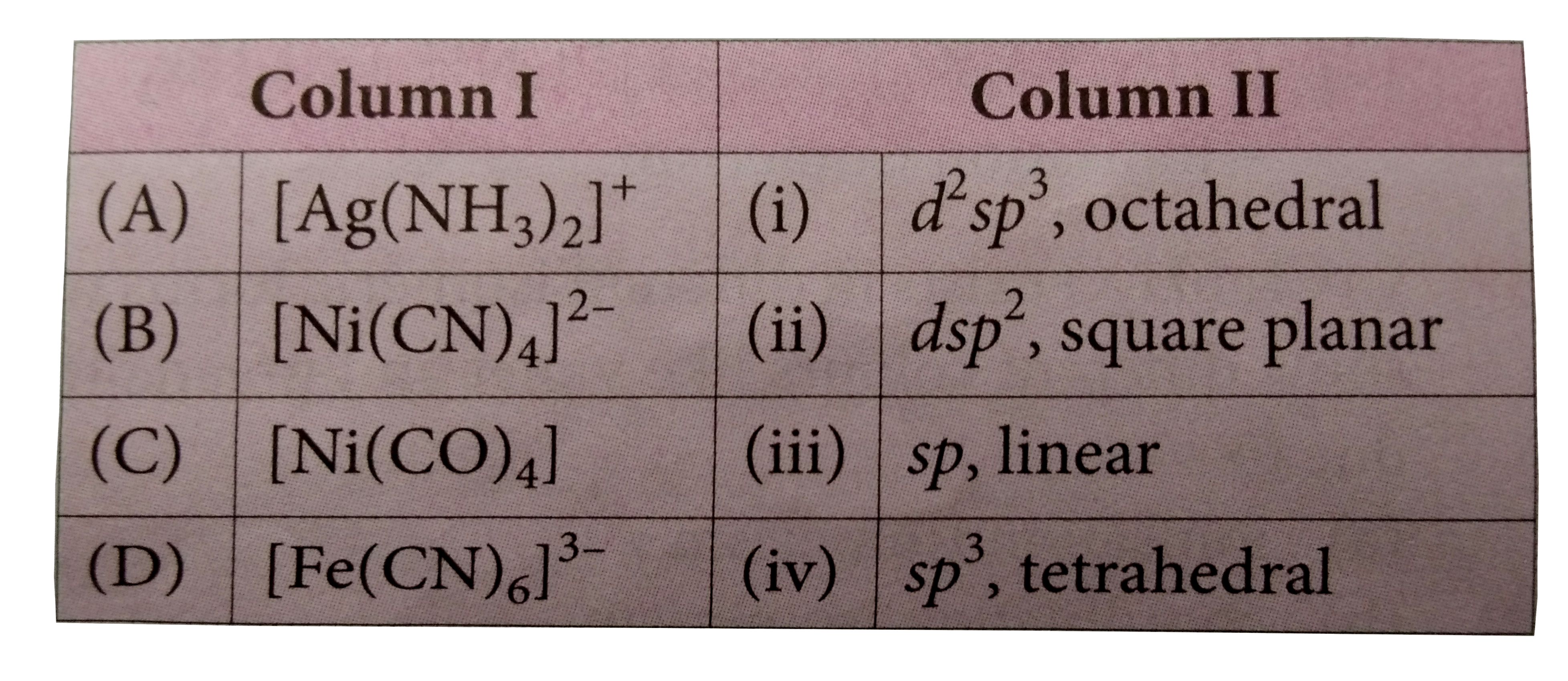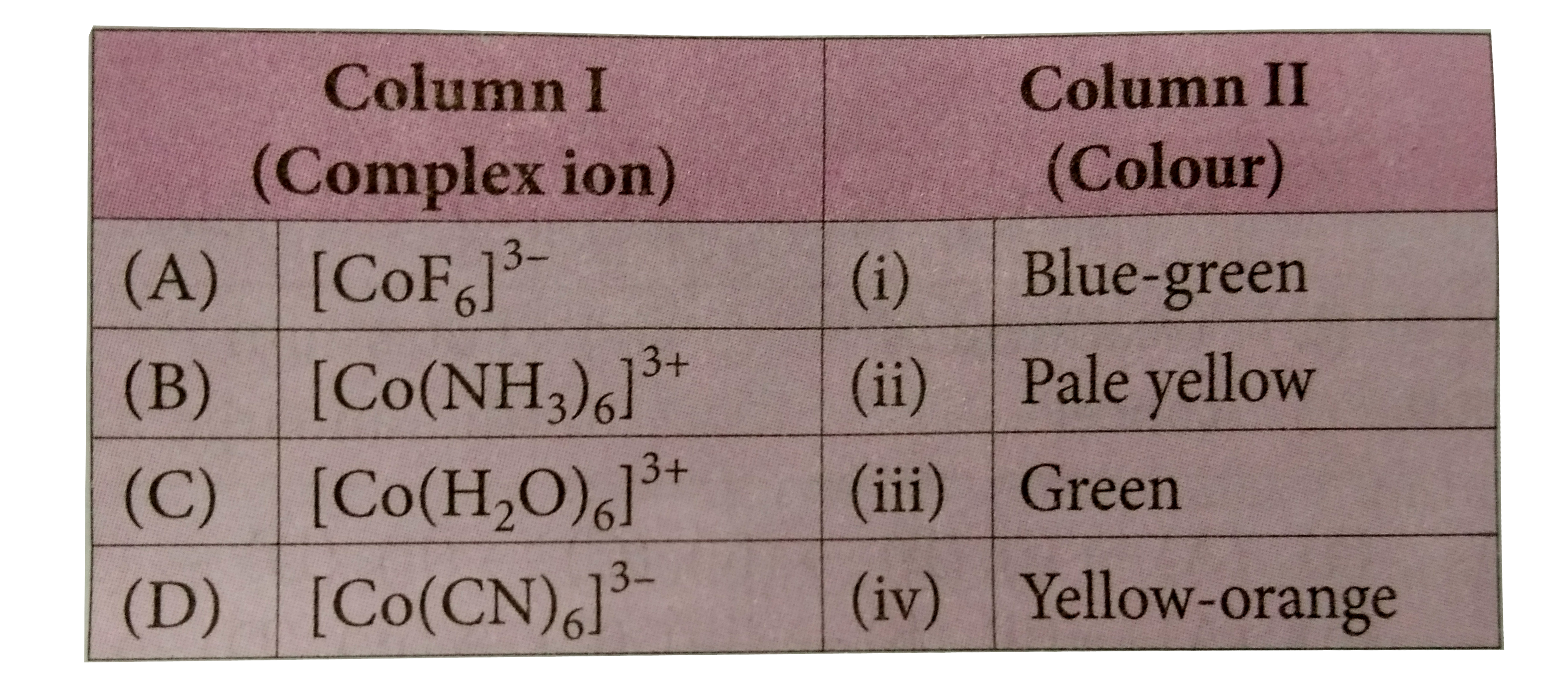Complete Solutions to Bonding In Coordination Compounds of chapter COORDINATION COMPOUNDS of Class 12 book with complete answers and questions
| Class 12 | CHEMISTRY |
| Chapter | COORDINATION COMPOUNDS |
| NCERT FINGERTIPS | Bonding In Coordination Compounds |
| Number Of Questions | 40 |
| Academic Year | 2023-24 |
The anion `[Co(C_(2)O_(4))_(3)]^(3-)` involves hybridization
05:15View SolutionWhich of the following sets of examples and geometry of the compounds is not correct ?
03:26View SolutionMatch the examples given in column I with the shapes of the compounds given in column II and mark the appropriate choice .
 05:31View Solution
05:31View SolutionWhich of the following is correct ?
03:15View SolutionMark the incorrect statement .
03:04View SolutionWhich of the following facts about the complex `[Cr(NH_(3))_(6)]Cl_(3)` is wrong ?
04:57View SolutionWhich of the following molecules has a regular tetrahedral shape?
04:54View SolutionMark the correct statements regarding the geometry of complex ions .
(i) The geometry of the complex ion depends upon the coordination number .
(ii) If coordination number is 6 , the complex is octahedral .
(iii) If coordination number is 4 , the geometry of the complex may be tetrahedral or square planar .02:16View SolutionThe complex ion which has no 'd'-electrons in the central metal atom is
View SolutionGive reason for the statement `[Ni(CN)_(4)]^(2-)` is diamagnetic while `[NiCl_(4)]^(2-)` is paramagnetic in nature .
03:28View SolutionThe lowest value of paramagnetism is shown by
04:21View SolutionExplain the following: (i)
[CoF_(6)]^(3-)` is paramgnetic but `[Co(CN)_(6)]^(3-)` is diamagnetic .01:36View SolutionDeduce the structures of `[NiCl_(4)]^(2-)` and `[Ni (CN)_(4)]^(2-)` considering the hybridisation of the metal ion. Calculate the magnetic moment (spin only) of the species.
04:41View SolutionWhich of the following has largest paramagnetism ?
03:52View SolutionUsing valence bond theory , the complex `[Cr(H_(2)O)_(6)]^(3+)` can be described as
04:38View SolutionWhich of the following descriptions about `[FeCl_(6)]^(4-)` is correct about the complex ion ?
02:41View SolutionWhen excess of ammonia is added to `CuSO_4` solution, the deep blue coloured complex is formed. Complex is
05:03View SolutionPick out the correct statement with respect to `[Mn(CN)_(6)]^(3-)`:
06:03View SolutionAmong the following the compound that is both paramagnetic and coloured is
06:52View SolutionThe spin only magnetic moment value of `Cr(CO)_(6)` is
03:01View SolutionWhich of the following complexes will show maximum paramagnetism ?
02:05View SolutionMatch the column I with column II and mark the appropriate choice .
 09:30View Solution
09:30View SolutionElectronic configuration of `[Cu(NH_(3))_(6)]^(2+)` on the basis of crystal field splitting theory is
02:46View SolutionWhich of the following energy level diagram for `[FeF_(6)]^(3-)` is correct on the basis of crystal field theory ?
03:23View SolutionIn `[NiCl_(4)]^(2-)` ,the number of unparied electron is
03:19View SolutionWhich of the following shell from an octahedral complex
03:43View SolutionThe value of 'spin only' magnetic moment for one of the following configuration is `2.84B.M.` The correct one is:
05:35View SolutionWhich of the following statements is/are correct ?
(i) In octahedral complexes , `t_(2 g)` orbitals possess low energy as compared to `e_(g)` orbitals .
(ii) In tetrahedral complexes , `t_(2 )` orbitals possess high energy as compared to e orbitals .
(iii) In octahedral complexes , `e_(g)` orbitals possess low energy as compared to `t_(2 g)` orbitals .02:57View Solution`[FeF_(6)]^(3-)` is paramagnetic due to presence of unpaired electrons in the complex . The five electrons remain unpaired because
02:53View Solution`[Co(C_(2)O_(4))_(3)]^(3-)` is a
02:16View SolutionWhat are the correct oxidation state , coordination number , configuration , magnetic character and magnetic moment of `K_(4)[Mn(CN)_(6)] ? `
03:57View SolutionWhich of the following statements is correct about `[Co(H_(2)O)_(6)]^(2+)` complex ?
05:01View SolutionThe increasing order of the crystal field splitting power of some common ligands is
01:29View SolutionWhat is crystal field splitting energy? How does the magnitude of `triangle_(0)` decide the actual configuration of d orbitals in a coordination entity?
07:18View SolutionWhy are low spin tetrahedral complexes not formed ?
03:47View SolutionA substance appears coloured because
01:38View SolutionMatch the complex ions given in column I with their colour given in column II and mark the appropriate choice .
 02:01View Solution
02:01View Solution`CuSO_(4).5H_(2)O` is blue in colour while `CuSO_(4)` is colourless. Why ?
02:32View Solution`[Fe(CN)_(6)]^(4-)` and `[Fe(H_(2)O)_(6)]^(2+)` are of different colours in dilute solutions why?
02:24View SolutionExplain why hexacayano complexe of metals in their +2 oxidation state are usually yellow , but the corresponding hexa aqua compounds are often blue or green .
03:24View Solution
Bonding In Coordination Compounds questions and complete solutions for chapter COORDINATION COMPOUNDS of MTG CHEMISTRY (ENGLISH) of Class 12
All Exercises from NCERT FINGERTIPS Class 12 CHEMISTRY COORDINATION COMPOUNDS
- Application Of Coordination Compounds
- ASSERTION & REASON
- Assertion And Reason
- Bonding In Coordination Compounds
- Bonding In Metal Carbonyls
- Definition Of Some Important Terms Pertaining To Coordination Compounds
- Higher Order Thinking Skills
- HOTS
- Isomerism In Coordination Compounds
- MCQs
- NCERT Exemplar
- NCERT EXEMPLAR PROBLEMS
- Nomenclature Of Coordination Compounds
- Warners Theory Of Coordination Compound
